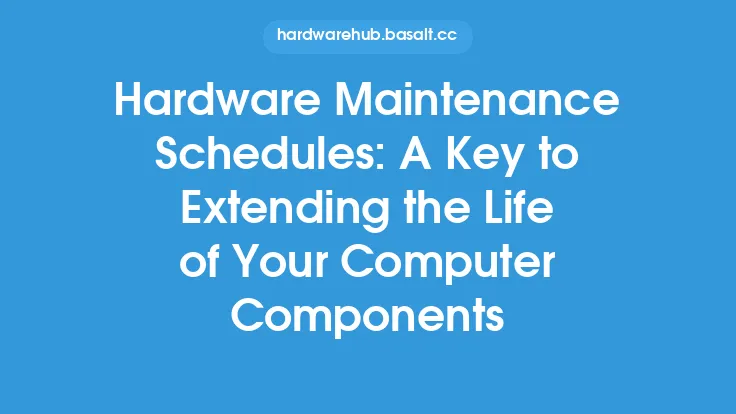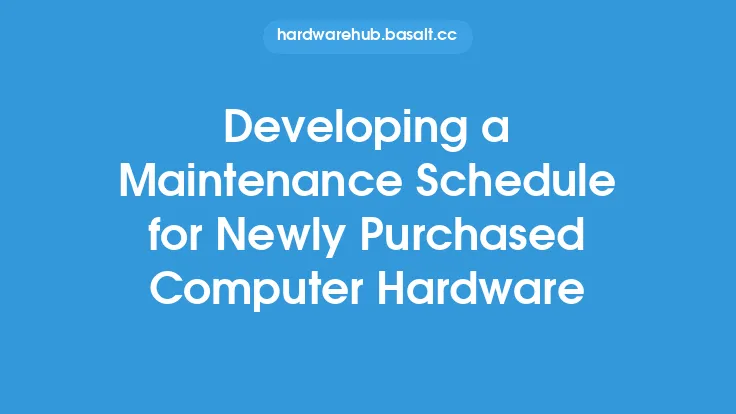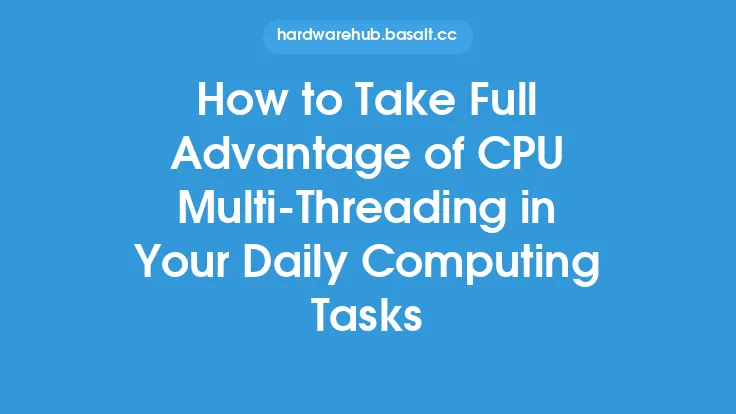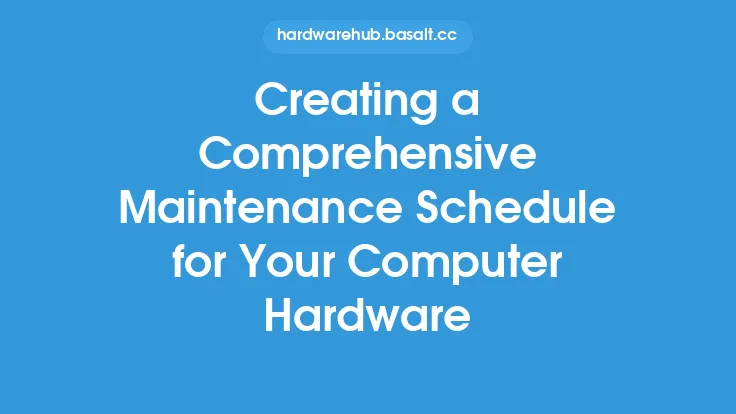To effectively manage and maintain computer hardware, it's essential to have a well-structured maintenance schedule in place. This schedule should outline the tasks that need to be performed, the frequency of these tasks, and the priority level assigned to each one. Prioritizing tasks in a hardware maintenance schedule is crucial to ensure that the most critical tasks are completed on time, and the hardware continues to function optimally. In this article, we'll delve into the details of prioritizing tasks in a hardware maintenance schedule, providing you with the knowledge and tools needed to create an effective maintenance plan.
Understanding the Importance of Task Prioritization
Task prioritization is the process of assigning a level of importance to each task in the maintenance schedule. This is based on the potential impact of the task on the overall performance and reliability of the hardware. By prioritizing tasks, you can ensure that the most critical tasks are completed first, and the hardware is protected from potential failures or downtime. For example, tasks such as cleaning dust from the CPU cooler or checking for loose connections should be given high priority, as they can significantly impact the performance and reliability of the hardware.
Identifying Critical Tasks
To prioritize tasks effectively, it's essential to identify the critical tasks that need to be performed. These tasks can be categorized into several groups, including:
- Preventive maintenance tasks: These tasks are designed to prevent hardware failures or downtime. Examples include cleaning dust from the hardware, checking for loose connections, and updating firmware.
- Diagnostic tasks: These tasks are used to identify potential issues with the hardware. Examples include running diagnostic tests, checking system logs, and monitoring system performance.
- Repair tasks: These tasks are used to repair or replace faulty hardware components. Examples include replacing a failed hard drive, repairing a faulty power supply, or upgrading the RAM.
- Upgrade tasks: These tasks are used to upgrade the hardware to improve performance or add new features. Examples include upgrading the CPU, adding a new graphics card, or installing a new sound card.
Assigning Priority Levels
Once the critical tasks have been identified, the next step is to assign a priority level to each task. This can be done using a numerical or alphabetical system, where tasks with a higher priority level are given a lower number or a higher letter. For example, tasks with a high priority level can be assigned a priority level of 1, while tasks with a low priority level can be assigned a priority level of 3. The priority levels can be based on the potential impact of the task on the hardware, the frequency of the task, and the resources required to complete the task.
Creating a Priority Matrix
A priority matrix is a tool used to visualize the priority levels of each task. The matrix consists of a table with two axes: the x-axis represents the urgency of the task, and the y-axis represents the importance of the task. Each task is plotted on the matrix based on its urgency and importance, and the tasks are prioritized accordingly. For example, tasks that are both urgent and important are given a high priority level, while tasks that are neither urgent nor important are given a low priority level.
Implementing a Priority-Based Maintenance Schedule
Once the priority levels have been assigned, and the priority matrix has been created, the next step is to implement a priority-based maintenance schedule. This involves scheduling the tasks based on their priority level, with the high-priority tasks being completed first. The schedule should also take into account the resources required to complete each task, including the time, personnel, and equipment needed. For example, tasks that require specialized equipment or personnel may need to be scheduled during a specific time period or at a specific location.
Monitoring and Adjusting the Schedule
The final step is to monitor the maintenance schedule and adjust it as needed. This involves tracking the completion of tasks, identifying any issues or delays, and making adjustments to the schedule accordingly. The schedule should also be reviewed regularly to ensure that it remains effective and relevant, and that the priority levels assigned to each task are still accurate. For example, if a task is found to be more critical than initially thought, its priority level can be adjusted accordingly, and the schedule can be updated to reflect the change.
Technical Considerations
When prioritizing tasks in a hardware maintenance schedule, there are several technical considerations that need to be taken into account. These include:
- The type and age of the hardware: Older hardware may require more frequent maintenance, while newer hardware may require less frequent maintenance.
- The operating system and software: The operating system and software used on the hardware can impact the maintenance requirements, with some systems requiring more frequent updates or patches.
- The usage patterns: The way the hardware is used can impact the maintenance requirements, with hardware that is used heavily requiring more frequent maintenance.
- The environmental factors: The environment in which the hardware is used can impact the maintenance requirements, with hardware that is exposed to dust, moisture, or extreme temperatures requiring more frequent maintenance.
Best Practices
To ensure that the maintenance schedule is effective, there are several best practices that should be followed. These include:
- Creating a comprehensive maintenance schedule that includes all the necessary tasks
- Assigning priority levels to each task based on its importance and urgency
- Scheduling tasks based on their priority level, with the high-priority tasks being completed first
- Monitoring the schedule and adjusting it as needed
- Reviewing the schedule regularly to ensure that it remains effective and relevant
- Documenting the maintenance activities, including the tasks completed, the resources used, and the results achieved.
Conclusion
Prioritizing tasks in a hardware maintenance schedule is crucial to ensure that the most critical tasks are completed on time, and the hardware continues to function optimally. By understanding the importance of task prioritization, identifying critical tasks, assigning priority levels, creating a priority matrix, implementing a priority-based maintenance schedule, monitoring and adjusting the schedule, and following best practices, you can create an effective maintenance plan that meets the needs of your hardware. Remember to take into account the technical considerations, such as the type and age of the hardware, the operating system and software, the usage patterns, and the environmental factors, to ensure that the maintenance schedule is tailored to the specific needs of your hardware.





